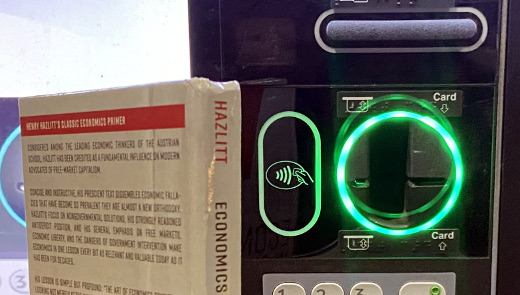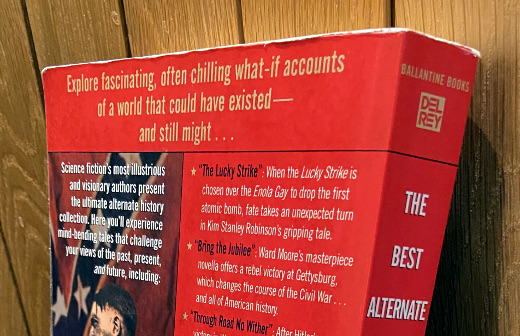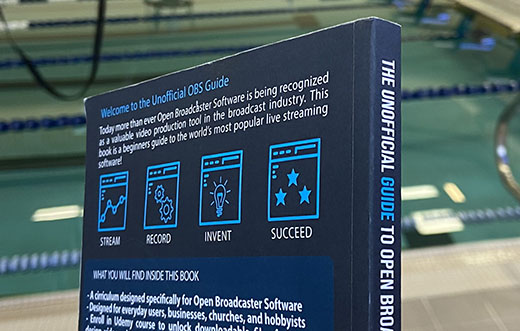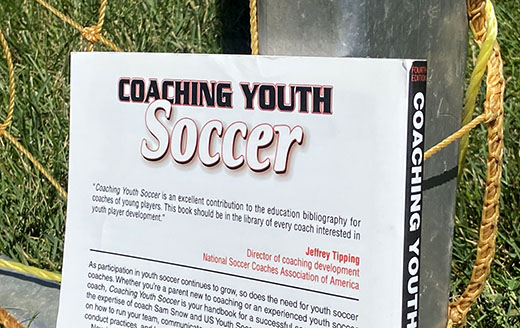My Takeaways From Economics In One Lesson

Economics. When you hear that word, what do you think? For some, it's a view of the world and how it operates. For others, they simply ignore it. For myself, as aware as I like to be of what happens in and around me, the topics of economics was always a fragmented one.
Taking Economics 101 in college didn't help things. It may have been a combination of things, including the nickname for my professor being "shaky" which was related to his hand gestures, how much alcohol he reportedly drank and likely both. The constantly exploding red pens in his shirt pockets was another distraction. I will never forget when he typed tests on a manual typewriter, he simply backspaced and put a slash thru mistakes and kept typing. Though these are no excuses, all my memories from that class are non-academic.
When I learned about a book called Economics in One Lesson by Henry Hazlitt, I had to check it out. Both being "one" lesson and being free were enticing to me. The book was offered by the Mises Institute, a libertarian think tank, and I took them up on their offer to receive a printed copy of the book, an offer unfortunately is no longer available. Hazlitt, a libertarian author, originally wrote the book in 1946 and it was revised and extended in 1979. As libertarians (and I am grossly summarizing here) believe in very small government and free markets, I was interested in what I learn from the text, as some of my own world views are in line with this thinking.
As I read through the pages of Economics in One Lesson, it helped me structure the bits and pieces of economics I have collected over the years, and I had several takeaways from it.
Simple examples – To setup what I was about to learn, in the early pages of the book was a hypothetical story of a store keeper who was saving for a new suit but had to spend the money on a new window when one in his shop was broken. As a result there was no net benefit to economy – the window glazer made out but the tailor did not, and neither did the store keeper for that matter. Stories like this and others help set the stage and drive home concepts throughout the book.
Global view – Hazlitt states that to truly study an economic impact you must trace both short and long term impacts and impacts on a special group and everyone impacted by it. He gave examples of laws and decisions made by governments that benefit one group at the expense of another, and that impact may be long after the decision is made and executed upon.
So what is Credit? – A statement that stuck out to me is regarding credit, that is something we already have not something a lender gives us. Granted if I walked into any bank and said that they would laugh at me and want to see my FICO score, but it is something I recall whenever the topic of credit comes up.
Economic Sybil – The idea that we have multiple economic personalities was something I hadn’t thought about. Some of those include being a producer, taxpayer and consumer, and the thinking around each will have some common and uncommon components.
Economics in One Lesson was an enjoyable read, something I wasn’t expecting for a book on this topic. It was written in a way to educate without shaming and didn’t pretend to be the one and only book you should read on economics, as in the end there were suggestions for further study. Where the offer to get this book for free no longer exists, I recommend picking up a copy if you are interested in learning or brushing up on economics. For the giveaway of this book, it is going to stay in the house for now as my lovely wife is interested in brushing up on what she learned here and abroad in economics.
This is from The Hot Iron, a journal on business and technology by Mike Maddaloni.
Did you enjoy this? Subscribe to The Hot Iron by RSS/XML feed or Read by Email
Book Take-Aways • (0) Comments • PermalinkMy Takeaways From Baby Steps Millionaire
Money. The mere mention of the word can evoke all kinds of thoughts and emotions. From joy to concern to comfort to panic to, oh crap, did I pay the electric bill this month?
Most all of us have money in some way, shape or form and the opportunity to do most all we want with it. But could you be a millionaire? I am sure some reading this are, some don’t care, some see no way and maybe some have no idea if they are or not. From game shows to lottery tickets to Austin Powers movies, the milestone of being a millionaire has been one known throughout the world.
But back to the question – could you be a millionaire? Dave Ramsey thinks you can. The long-time radio and TV host of personal finance programming and author has been professing common sense regarding money and finance for decades. Where I have been aware of him and seen and heard his shows on occasion, I have never really dove into what he professes. When I heard of his recent book Baby Steps Millionaire, I was intrigued and picked up a copy.
Baby Steps Millionaire tells the tales of people who became millionaires – they have a net worth of or over one million US dollars and how they achieved it. As I read through the book, a few takeaways formed in my mind.
People and how they did it – Where I am not trying to spoil the book for you if you are equally intrigued to read it, it may not come as a surprise for the majority of them there was no “fast path” and it involved sound spending and investing over time. There are many stories that are somewhat similar in context in how people reigned in spending, cut expenses and made lifestyle choices and saved even when they didn’t think they could. These stories make up the first half of the book, and though after a while they become a little repetitive, Ramsey is merely driving home the point on how you can be a millionaire too.
Survey says – The second half of this book is the results of a survey of millionaires, and builds and heightens the first half with more concrete data. It starts out going into rather detail about how the survey was developed and conducted (maybe all surveys do this, I don’t read many surveys in this kind of detail) and then shows the results of what millionaires say about how they got to where they are. Sure, a few inherited their millions from the infamous long-lost uncle, but many followed the sound money steps that were driven home in the first part of the book to get to where they are.
Off-site storage – Dave Ramsey’s first baby step to financial stability is one I have known for years in setting up an emergency fund with $1,000. If you get into a bind, it’s the thing you break the figurative glass of and tap into, then work to replenish it. Though we have savings accounts of different ilk, my family did not have a specific emergency fund, and now we do. But $1,000? Today?! A small amount comes out of each of my wife and I’s paychecks and goes into the account that is at a bank that isn’t our primary and one we have to make an effort to get to. It’s a good feeling to finally have this.
Baby Steps Millionaire is a good read that I recommend as a friendly reminder of how you can achieve financial goals, whether you want to be a millionaire or not. Where some of it can be repetitive, it is a positive book that shows many examples of how people got onto a financial track and took off. As I give away all books I read, I am giving this one to someone who is getting back on track in many ways, and I hope it gives them inspiration when it comes to the M word.
This is from The Hot Iron, a journal on business and technology by Mike Maddaloni.
Did you enjoy this? Subscribe to The Hot Iron by RSS/XML feed or Read by Email
Book Take-Aways • (0) Comments • PermalinkMy Takeaways From The Best Alternative History Stories Of The 20th Century

What if? What if the atomic bomb was never dropped on Nagasaki? What if McGovern beat Nixon in the 1972 US Presidential election? What if Hitler was victorious in World War II?
It’s hard to imagine how life as we know it would be if history as we know it was different. Or is it? I recently found this topic little easier to comprehend when a colleague gave me a copy of The Best Alternative History Stories Of The 20th Century.
At over 400 pages, this book has 14 individual stories that fall into the genre called “alternative history.” For those not familiar with this genre, the stories are based on an event or period of time in history that is reimagined with a different outcome. The result is a collection of tales of what could have been different, making you think even more as you turn the pages of this assortment of fiction. Not only was I thinking about alternative outcomes as I read this book, a few takeaways leapt from its pages as well.
I didn’t know this genre existed before this book – Where I have repeated here on the posts of this humble blog that I am no prolific reader, I certainly backed up that statement when it came to alternative history. I had never heard of the genre before I read the book. That helped me get to the several hundred pages as I was intrigued at what would be the “best” of stories.
No two stories were the same – As each tale of an alternative outcome were written by different authors, the stories were as unique as the individuals. Some were short, some were long. Some were painstakingly detailed, others glossed over minutiae in exchange for plot and character development. Some were about a specific event itself and others were related to activities as the result of an alternative history. In the end I mostly appreciated the variety of styles as much as their topics.
I never finished 2 of the stories – Two of the stories were very hard to follow and I decided after several pages to skip them. One was about a period of time I didn’t quite understand when it was and the story was difficult to follow. Another had a very complex style that made it hard for me to read. Where I have read every page of every book I’ve written about, this is the first time I did a fast-forward on a few.
The Best Alternative History Stories Of The 20th Century was unique in how it made me think at different levels, and is a book I highly recommend. When I make more room in my bookshelf I will certainly consider adding alternative history stories to it. As I pass along all books I read, this is going to one of my favorite cousins, both for her enjoyment and to help atone for missing her recent birthday.
This is from The Hot Iron, a journal on business and technology by Mike Maddaloni.
Did you enjoy this? Subscribe to The Hot Iron by RSS/XML feed or Read by Email
Book Take-Aways • (0) Comments • PermalinkMy Takeaways From The Unofficial Guide to Open Broadcaster Software

As I have talked about before at great length, when I entered the world of livestreaming I literally dove head first into the pool and checked for water afterwards. Pun intended, as I have been livestreaming swim meets going on 2 years now. Within a short amount of time I was able to learn the basics and do a good job with that knowledge.
Through all of this I knew there was more to it, especially as there’s a number of resources available online about livestreaming. Where searching on topics has yielded me decent results, I also wanted to put some structure around my learning journey.
My quest led me to the book The Unofficial Guide to Open Broadcaster Software by Paul Richards. It is based on a class his firm Streamgeeks offers on the Udemy learning platform. As I have watched several of his videos and this was one of few printed books available on the OBS software we use to manage the livestream, I decided to buy a copy of it. Note you can request a PDF download of the book for free by filling out a form.
This book did not disappoint – it provided in a narrative style a top-down approach to livestreaming, chock full of examples and diagrams to provide a complete package of learning. As I went through the pages, I had the following takeaways from this book.
Provided the structure I needed – As a GenXer, my historical approach to learning is far from digital-first. Where I have taken many online courses that had no printed or tangible materials, it was refreshing to be able to have this printed book, carry it with me and read from cover-to-cover. The organization was just right and it gave me structure I would never have gotten from a YouTube playlist.
Validated a lot of what we are doing – With the approach I took with livestreaming, coming at it from all angles, I wondered how much I wasn’t doing that I should be. After reading this book, I did find a few things I wished I knew up-front. However it validated much of what we had done, and that gave me a great feeling. Granted we got compliments from many people on the end-product, but it’s also good to know we have used best practices to that end.
Learned plenty of tips – As I read the book, I took a lot of notes. Many notes were on things we haven’t done, and others were on what we were doing and options to consider. The list is something I am now working from to enhance our livestreaming process.
I highly recommend The Unofficial Guide to Open Broadcaster Software to anyone who is thinking about livestreaming or is already doing it, like myself. Certainly there are technical aspects to the book that may be beyond someone’s comfort zone, but if you’re looking to getting into livestreaming, they are important to learn and explore. There is a second edition to the book that I have also read, OBS Super User Guidebook: The Best Open Broadcaster Software Features & Plugins, that builds on the first edition and a writeup of takeaways from that would be similar to this one. This book too is available in print format or as a free PDF download. I plan on writing a follow-up to my original blog post on what I learned of livestreaming swim meets and will include these tips in that post.
As I share all books I read, I passed this copy along to one of my fellow livestreaming Swim Dads, someone who has been a great partner with me on this broadcasting journey, so he can share in the information and motivation to improve our livestreams.
This is from The Hot Iron, a journal on business and technology by Mike Maddaloni.
Did you enjoy this? Subscribe to The Hot Iron by RSS/XML feed or Read by Email
Book Take-Aways • (0) Comments • PermalinkMy Takeaways From The Book Coaching Youth Soccer

A couple of years ago my universe started on a collision course with another, as one of my kiddos decided to take up soccer. What started slowly quickly picked up quantum momentum to the point she had taken to the wing and goalkeeper positions, with the latter leading her to winning a local qualifier for a national goalie competition she played in this summer.
Where her and my other spawn were both swimmers, I had one body of knowledge to grow and learn about. Now I had another. Where I was picking up tips on the game from other parents who were lined up along the sideline of the field, I didn’t know all I didn’t know about the game. To that end, my wife picked up for me a copy of Coaching Youth Soccer by American Sport Education Program – not that I would be the team coach (we actually have some awesome coaches) but that I could understand better who was in what position and actually see an offsides before the referee called it.
Coaching Youth Soccer is a comprehensive book, talking about the type of person who can be a coach and all to think about, above and beyond who is kicking the ball to whom. Illustrated with diagrams and photos, I was able to easily follow along, noting takeaways as I learned what my kiddo has obviously already learned.
There’s a lot more to soccer than I thought – Your humble author actually played soccer for 2 seasons. As this is the first time I have ever mentioned it on this humble blog, you are accurate to assume I was not that good. Going into her playing and prior to reading this book, I did know you should not kick the ball with your toe and you should wear shin guards, among a few other basics. From the types of kicks, passes, formations and how they advance as the players age up, there was a lot to learn here. I can’t say after I finished the book I knew and remembered it all, but it gave me the foundation from which I can build on.
Teaching and coaching – Most of my exposure to sports coaches have been through swim and the NFL. Where for the latter I only had distant awareness of the actions of coaches, through swim I recognized what makes a good coach, not to mention what results in a bad coach. This book opens up talking about this and other aspects of the role of a coach – including as a teacher – long before gets into fundamentals. Though all styles are as unique as the individuals, there’s a common thread for good coaches that is obvious in the enjoyment of the game by the player and success of the team.
Not something I want to do – Where I have managed technical teams and software projects of various sizes, coaching a team of about a dozen and a half kiddos is not something I want to do. There are other aspects of the team I am more than glad to contribute to, but coaching is not one. Granted I have filled in when coaches were stuck in traffic on more than one occasion, but I will leave this to the people who are great at it.
Coaching Youth Soccer was a good read and one I actually have gone back to once or twice since I finished it. As it was endorsed by US Youth Soccer, the governing body of the game for kiddos, it is authoritative yet approachable. If you are new to the game or considering stepping up to be a coach, I recommend reading the book. Note the version I read was the fourth edition from 2006 and likely there have been updates, so picking up a more recent copy may be in order if you’re more than a casual reader of it like I was.
As I pass all books along to others after I read them, I am going to offer this to other parents on her team. There’s a mix of parents who actually played the game and those who haven’t, so there may be interest in someone to better understand their kiddos current (and future?) passion. In the meantime, I am still on the quest to see an offsides before it is called.
This is from The Hot Iron, a journal on business and technology by Mike Maddaloni.
Did you enjoy this? Subscribe to The Hot Iron by RSS/XML feed or Read by Email
Book Take-Aways • (0) Comments • Permalink

